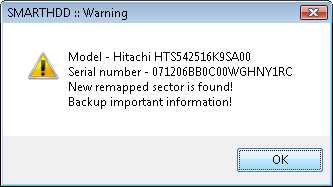S.M.A.R.T. Technology
S.M.A.R.T. (Self-Monitoring, Analysis, and Reporting Technology) is the technology of estimation of the state of an HDD and prediction of its failure. It was developed by manufacturers of hard drives for providing a higher degree of reliability of storage of the information. The reliability of a storage device has always been critical, and the matter is not in its cost at all but in the value of the information which can be lost forever in case of the disk drive failure. The essence of S.M.A.R.T. technology is that the hard drive independently watches its state, and the particular program which is carrying out monitoring of S.M.A.R.T. parameters of a disk is capable of warning the user about a pre-emergency state of the device beforehand. After the warning is received, users have an opportunity to undertake the operations necessary for providing the safety of their data.

Failures can be conventionally divided into predictable and unpredictable. Unpredictable failures occur fast, e.g. voltage surge damaging the electronic circuit, the damage of magnetic heads and the damage of the magnetic disk surface caused by the blow. Improvement of quality, construction, technology, and production reduces the probability of random crashes. Predictable failures are characterized by the step-by-step degradation of one or another parameter. Many mechanical failures are usually regarded as predictable. With the development of S.M.A.R.T. technology, the increasing number of failures becomes predictable and gets in the field of its responsibility, increasing the probability of the failure prediction. During disk drive work S.M.A.R.T. watches all the occurring errors and the suspicious phenomena which are reflected in appropriate attributes.

The number of attributes for various models and manufacturers differs. Each attribute has the value from 0 to 253. Its value is the reliability of the concrete attribute regarding its particular standard value defined by the manufacturer. A high value means the absence of changes in the given parameter. A small value means fast degradation or the possible forthcoming failure, i.e. the higher the value of the attribute is, the better. For each attribute, the manufacturer defines the minimum possible value at which the non-failure operation of the disk drive is guaranteed. At a value of attribute below this value, the failure in operation or total failure is very probable. Attributes can be critical and noncritical. Critical parameter coming outside the limits means failure, while noncritical parameter coming outside the limits testifies that there is a problem at which the HDD preserves its working capacity, though with some performance degradation.